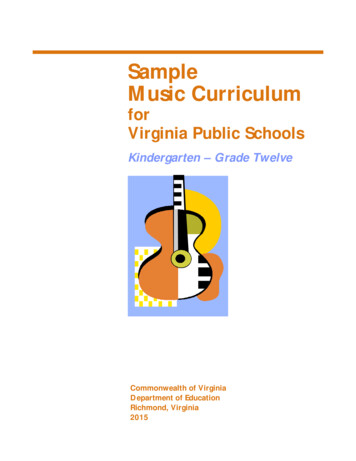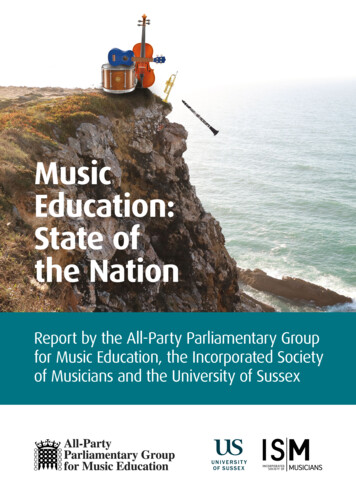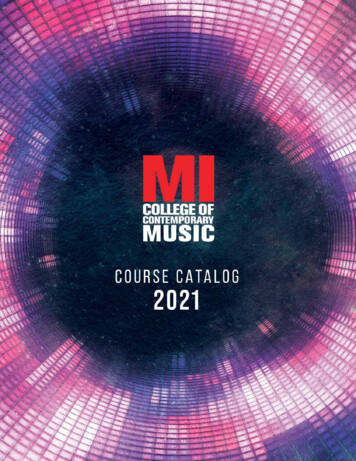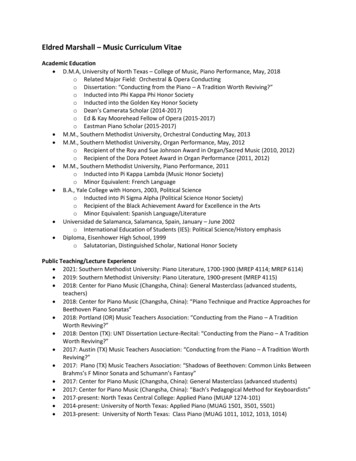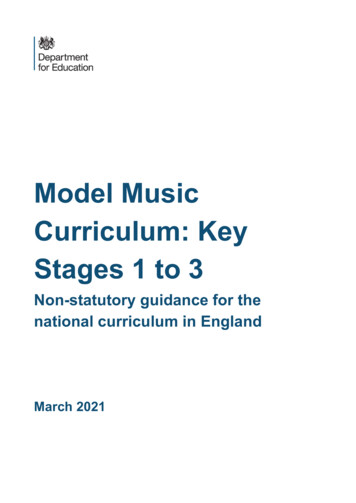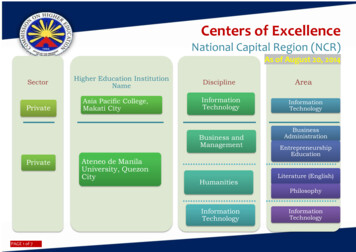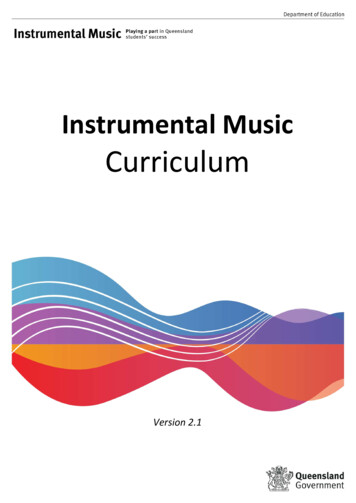
Transcription
Instrumental MusicCurriculumVersion 2.1
Instrumental Music Curriculum 2021 Department of Education, Queensland Government, 2021Department of Education30 Mary Street, BrisbanePO Box 15033, City East, 4002Instrumental Music Curriculum, version 2.1Page 2
ContentsRationale .4Course Organisation .5Instrumentation. 5Course Components . 5Time . 5Content Structure .6Dimensions . 6Objectives . 6General Capabilities and 21st Century Skills .8Application of General Capabilities and 21st Century Skills to Instrumental Music Curriculum . 8Links to Other Learning Areas . 9Scope & Sequence .10Level 1 . 10Level 2 . 12Level 3 . 14Level 4 . 16Level 5 . 18Level 6 . 20Level 7 . 22Level 8 . 24Level 9 . 26Level 10 . 28Assessment .30Principles of Assessment . 30Assessment Conditions . 31Achievement Standards. 32Appendix .33I.Sample Level Assessment Plan . 33II.Sample Worked Profile . 34III.Sequential development of scales (including arpeggios) . 35IV.Range Chart . 36Instrumental Music Curriculum, version 2.1Page 3
RationaleMusic is a unique and integral part of life. It has the capacity to inspire all students’ creativity and imagination,engage them in the art of expression, immerse them in a language and history that is rich in culture, provide themwith opportunities beyond the classroom and excite them about life and learning.The skills, concepts and attitudes that students acquire as a result of music education benefit them not only duringtheir schooling but also in the years beyond, whatever their chosen career path.The overarching purpose of the co-curricular Instrumental Music Program is to provide students with theopportunity to become musicians by experiencing the expressive qualities of music through learning to play a bandor orchestral instrument and participating in concert bands and orchestras as performance ensembles.Instrumental Music is built on a comprehensive combination of learning styles and experiences. Students developincreasing confidence and musical sensitivity throughout their years of learning as they engage with progressivelycomplex techniques and a broadening range of genres and styles of music.As a compatible and complementary curriculum to those of primary and secondary classroom music and musicextension programs, Instrumental Music provides opportunities for greater participation in, and enrichment of,music education for the whole school community. The program fosters opportunities for interaction between yearlevels through participation in school-based ensembles, as well as for cross-linking to other areas of the schoolcurriculum.Engagement in the program will improve the quality of perception and self-expression by fostering the acquisitionof musical skills, thereby increasing aesthetic sensibility, cultural awareness and social-emotional engagement.Through the lens of music, students are empowered to make sense of their world.Instrumental Music Curriculum, version 2.1Page 4
Course OrganisationThe Instrumental Music curriculum enables teachers to plan a course of study through which students becomemusicians, through the development of musical literacy, technique and performance. The course seeks to extend astudent’s musical experience through participation in large performance ensembles as well as small group lessons.InstrumentationThis curriculum includes band and orchestral instruments, organised in families, as follows: Strings—violin, viola, cello, double bass, bass guitar*;Woodwinds—flute, oboe, bassoon, clarinet, saxophone;Brass—trumpet, French horn, trombone, baritone, euphonium, tuba;Percussion—tuned (mallets and timpani) and untuned (snare, auxiliary and drum kit) instruments**.*For the purposes of this curriculum, requirements for the bass guitar will be addressed under the strings family. As part of whole-schoolplanning for the provision of the curriculum, schools choose for the above instruments to be taught by the most appropriate teacher.**Levels 1-3: snare and mallets are formally assessed; Levels 4-6: timpani, snare and mallets are formally assessed; Levels 7-10: 3 of mallets,timpani, snare and drum kit are formally assessed, plus scales on mallets. All instruments are performed in ensemble as per repertoire.Course ComponentsStudents become musicians through participation in the Instrumental Music program which incorporatesperformance ensembles, small group lessons and home practice. All three course components are required forprogress and achievement in the subject.Performance EnsemblesEnsembles provide the opportunity to demonstrate instrumental music learning in real-life contexts. The ensembleexperience is enabled through the formation of school symphonic concert bands and orchestras. Schools may runoptional extension ensembles such as stage bands and percussion ensembles.Group LessonsSmall group lessons are the avenue through which music literacy, techniques and performance skills, specific to theinstrument and level of the student, are explicitly taught. Lesson groupings are arranged according to the learningneeds of the student and the school context. Most often, these are like-instrument and/or like-ability levels.Home PracticeIt is expected that students will complete regular home practice to make musical progress on their instrument.Teachers should provide resources and teach routines around home practice for students as needed.TimeExpected ProgressWithin the Instrumental Music course of study, progress is sequential and cumulative. Students typically progressthrough each level within 8-12 months. While varied pace is recognised as a common modification for students inneed of support, the aim for students in most cases should be to progress to the next level at least once per year.Students who enter the program later in their schooling may progress through the curriculum levels at a faster rate.TimetablingStudents may engage in the program from year 3 (strings) or year 4 (band) to year 12. The weekly contact timerequired for the program includes 1 x 1hr ensemble rehearsal and 1 x 30-35min group lesson, as well as regularhome practice.Instrumental Music Curriculum, version 2.1Page 5
Content StructureDimensionsThe dimensions of the program are music Literacy, Technique and Performance, all of which contribute towards theultimate goal of “students becoming musicians”. The dimensions are interrelated and should be taught as such,with success in any one dimension being reliant upon development in the other dimensions.Dimension 1: LiteracyMusic literacy is integral to students becoming musicians as they learn to decode, interpret and understand whatis meant by all that is written on the music, and to demonstrate that understanding through what they play on theirinstrument.Dimension 2: TechniqueThe skills and techniques involved in playing an instrument are wide-ranging and complex and are refined over along period of time. In the dimension of technique, specific skills of how to best play the instrument are taught.Good technique is essential for students to become musicians.Dimension 3: PerformanceThe dimension of performance is the synthesis of literacy and technique. Musical performance takes the individualskills and techniques learnt in the other dimensions to a level beyond accurately playing the notes on the page.Musicians stylistically apply artistry and creativity to produce a holistic and musical performance.ObjectivesOrganised under these three dimensions are ten curriculum objectives that should be explicitly taught across allstrands or families. The ten objectives are summarised below, and further expanded in the Scope and Sequenceand Achievement Standards sections of this curriculum.Instrumental Music Curriculum, version 2.1Page 6
Literacy (demonstrated through performance)Instrument Demonstrate appropriate use of the instrument, with familiarity of all aspects of the instrument, includingmaintenance as appropriate, and a basic knowledge of other ensemble instruments. Manipulate the instrument as appropriate, through alternate fingerings, harmonics, changes of tonecolour etc.Symbols & Terms Interpret all music symbols and terms as used in their repertoire.Rhythm & Melody Stylistically and accurately perform notes and rhythms, in a range of forms, textures, tonalities, metres,and styles.Sight Reading Sight-read music at two levels below current performance standard.Technique (demonstrated through performance)Posture Develop a total body posture (including finger, hand and arm positions) that permits the most efficientmovement for playing the instrument and allows for the stamina needed in performance.Tuning & Intonation Tune the instrument to required pitch/es. Play with good tuning and intonation. Adjust pitch while playing.Tone Produce appropriate tone quality while playing.(Where appropriate) include vibrato as an aspect of tone.Contribute to the overall blend and balance of the ensemble.Articulation Articulate through tonguing, breathing, bowing, or striking. Interpret and perform articulation in different styles of music.Pitch Repertoire Demonstrate the full capabilities of their instrument's range. Play from memory major and minor scales and arpeggios at the appropriate level.PerformanceSolo & Ensemble Performance Perform with a sense of artistry and musicality, synthesising musical literacy and technique. Perform as a soloist and in ensembles, from music notation and from memory. Stylistically perform in an increasing range of genres, historical periods and musical forms. Respond to conducting directions and cues, and contribute to the ensemble. Demonstrate ensemble skills and active engagement in rehearsals and performances. Perform own part to contribute to the ensemble, with increasing independence and musical outcomes.Instrumental Music Curriculum, version 2.1Page 7
General Capabilities and 21st Century SkillsThe Australian Curriculum, Assessment and Reporting Authority (ACARA) highlight seven General Capabilities thatdescribe key understandings, skills, and dispositions important for young Australians to live and work successfullynow and in the future. These General Capabilities have clear alignment to Queensland Curriculum and AssessmentAuthority (QCAA) 21st Century Skills which support young Queenslanders to be innovators, entrepreneurs, lifelonglearners and responsible global citizens.Application of General Capabilities and 21st Century Skills to Instrumental Music CurriculumThrough the Instrumental Music Curriculum teachers make explicit the connections to Australian Curriculum:General Capabilities and 21st Century skills. Students engage in cognitive processes (knowledge utilisation,analysis, comprehension, retrieval) to become confident and capable racy21st Century Skills(QCAA)CommunicationCritical thinkingCritical andcreative thinkingPersonal andsocial andingDigital LiteracyInstrumental Music Application*In Instrumental Music, students’ literacy andnumeracy skills increase by learning to understandand interpret musical notation as a unique language.Students analyse, evaluate, critique, reflect andinterpret performances to become confidentmusicians.In synergising of literacy, technique and performance,students have opportunities as musicians to developCreative thinkingand demonstrate creative thinking. Students developtheir identity through creativity.In Instrumental Music, students build personal andPersonal and social social capability and actively engage in wellbeingpractices as they develop as solo and ensembleskillsmusicians.Through ensembles, students develop a collaborativeCollaboration andapproach to learning by developing inclusive, ethicalteamworkand intercultural understandings.ICT skillsInstrumental Music Curriculum, version 2.1Students’ digital literacies are developed through IMwhen they engage with digital technologies to makeand respond to music.Page 8
Studentsbecomingmusicians*Further information on the associated skills and suggested application for the Instrumental Music context is available in IM CurriculumAppendices.Links to Other Learning AreasThe ArtsThe most obvious links from Instrumental Music to other Learning Areas are to The Arts 1 and Senior Music 2syllabuses. There are vast benefits for students engaged in both classroom and Instrumental Music programsthroughout primary and secondary school. The courses complement each other in many ways; however, one doesnot replace the other. Skills developed in classroom music, such as music literacy and musicianship, form anessential foundation for the Instrumental Music program. The Instrumental Music program further developsstudents as musicians which deepens their ability to engage in the classroom music program.Other Learning AreasBeyond the general capabilities and links to The Arts, strong links exist between Instrumental Music and otherlearning areas, such as: 12Science (acoustics, physical properties of sound, influences of temperature on the instrument and biologyin the use of the body to play);Mathematics (number, beats/bars/measures/subdivision);Humanities and Social Sciences (understanding the historical and cultural contexts of music); andLanguages (understanding music symbols and ps://www.qcaa.qld.edu.auInstrumental Music Curriculum, version 2.1Page 9
Scope & SequenceLevel 1Skills and techniques are cumulative across the levelsAll Instrumental Music INST Correctly assemble and maintain the instrument for effectiveperformance. S&T Using symbols and terms, including:whqW H Q c ]} {fpStrings INST perform with aproperly-tensioned and-rosined bow. S&TLiteracyK L J as found in repertoire. PerformanceTechnique Pizzicato, arco,open string, detachéretake/ bow lift.Finger patterns:VN/VA – 1-23-4VC – 1-34CB – 1-40Ledger lines, bar, bar lines, divisi, unison, solo, soli, duet, tutti,accidentals, 1st and 2nd time endings, multiple bar rests, dynamics,key signature, staff, clef/s (found in repertoire), time signature,metronome marking, rehearsal marks, major scale, scale, arpeggio.Other symbols and terms as found in repertoire or as required in theTechnique dimension.R&M Play simple rhythmic and melodic patterns found in repertoire,keeping a steady pulse. Perform repertoire in major keys.Ensemble repertoire keys (concert pitch): BL (band); D (strings).SR Play, at sight, simple music of up to four bars (eg. using a single notewith simple rhythms).POST Perform with appropriate and effective playing positions, includingtotal body, arm, hand, wrist and finger positions.T&I Improve intonation by adjusting pitch as appropriate.TONE Produce an even, sustained tone, and variations in loudness andsoftness in sound.ART Play with articulation appropriate to instrument and level ofrepertoire.PITCH Play diatonic pitches within the prescribed range in repertoire andthrough scales and technical exercises (refer to Appendix IV Range Chartfor specific instrument ranges throughout). POST Effective LH shapeincluding 4th finger.Appropriate and effectivebow hold (balanced,functional, mobile).CB – either French orGerman bow.BG – adjust bass guitarstrap to correct length. T&I Use secure fingerpatterns to developaccurate pitch. TONE BG clear focusedtone with 1st & 2nd fingers.OS – even, sustained tonewith bow, pizzicato. ART Smooth crossing toadjacent string (detaché).BG – LH dampening. PITCH VN/VA/VC – 1stposition.CB – 1st and 3rd position.BG 1st, 2nd and 3rd fret.Demonstrate literacy and technique appropriate to this level, synthesised in a musical performance.Perform individually and in an ensemble. Perform from music notation and from memory.Perform repertoire in a range of styles.Follow conducting patterns and cues.Demonstrate ensemble skills and active engagement in rehearsals and performances.Perform part within the ensemble. Perform unison and two-part, rhythmic unison and homophonicrepertoire.Instrumental Music Curriculum, version 2.1Page 10
Woodwind S&T@ nBrass INST TBN (trigger) – usingtrigger for C.EUPH (4-valve), TBA (BL, 4-Slurs, ties, crescendo,decrescendo, phrase, breathmark, accent, anacrusis.valve) – using 4th valve for C.Percussion INST Correct use of eachinstrument as found inrepertoire. S&TTBA (EL, 4-valve) – using 4thS&T@ nSticking (R,L), crescendodecrescendo, phrase, accent,anacrusis, tacet, rim, ties.SD –Literacy valve for BL and F.@ nSlurs, ties, crescendo,decrescendo, phrase, breathmark, accent, anacrusis.TBN – slide lock. POST Instrument held with finger tips on the top ofvalves and ergonomicallycorrect grip to holdinstrument appropriately.Characteristic embouchurewith appropriate pressure/seal on mouthpiece.TBN – pistol gripdemonstrated in LH.TONE Establish clear,sustained notes within rangeusing controlled and consistent air speed.Resonant, characteristic tone.ART Basic articulations,including slurring.PITCH Buzz simple tunes atpitch and make “siren” soundon mouthpiece.POST Matched grip.AUX – correct striking/muffling technique and handposition for all auxiliaryinstruments as found inrepertoire.T&I, TONE Produce aconsistent tone with bothhands. Play in the centre ofthe drum/mallet notes.MLTS – use wrists to bouncemallets off notes.ART SD – alternating singlestrokes, double strokes, singleparadiddles, flams, accents,crotchet multiple bouncestrokes.MLTS – alternating singlestrokes, double strokes onsame note quavers.Technique POST Keep fingers close tothe keys and thumbs incorrect position. Correct useof neck or seat strap asappropriate.Characteristic embouchureformation.FL – 3 balance point hold.OB – breathe out to releaseany excess air beforebreathing in again.T&I OB – adjust intonationthrough air support andembouchure.TONE Establish clear,sustained notes within rangeusing controlled andconsistent air speed.Resonant, characteristic tone.ART Basic tonguing andslurring.PerformanceObjectives key: INST Instrument, S&T Symbols & Terms, R&M Rhythm & Melody, SR Sight-Reading, POST Posture, T&I Tuning & Intonation, ART Articulation, PITCH Pitch RepertoireInstrument key: VN violin, VA viola, VC cello, CB double bass, OS orchestral strings, BG bass guitar,FL flute, OB oboe, CL clarinet, SAX saxophones, BSN bassoon, REED all reed instruments,TPT trumpet, FH French horn, TBN trombone, TBA tuba, EUPH euphonium,SD snare, MLTS mallet percussion, TIMP timpani, AUX auxiliary percussion, KIT drumkit/setInstrumental Music Curriculum, version 2.1Page 11
Level 2Skills and techniques are cumulative across the levelsAll Instrumental Music INST Correctly assemble and maintain the instrument for effectiveperformance. S&T Accurately perform symbols and terms including:Literacy# d F Y PerformanceTechnique mf mpChord, D.C al Coda, D.C. al Fine, tempo, Andante, Allegro, Moderato,introduction, canon/round, system, brackets.Other symbols and terms as found in repertoire or as required in theTechnique dimension.R&M Observe breath marks, phrase marks or bowing marks.Imitate rhythmic and melodic patterns and phrases of up to two barsduration where the starting note is given and melodic movement is bystep. Perform in stylistically appropriate manner. Perform in major andminor tonality as per repertoire. Ensemble repertoire keys in theseStrings S&T@nTone, semitone, bowdivision, double stop, ties,slurs, phrase, accent,tenuto, anacrusis.Finger patterns:VN/VA 12-3-4VC 12-4CB 12majors and their relative minors (concert pitch): BL (band); G (strings).SR Play, at sight, simple music of up to four bars (eg. using up to the first5 notes in stepwise motion or on open strings, with a single note valueand its corresponding rest).T&I Tune open strings to agiven pitch.BG – correctly adjustvolume controls. TONE Effective use ofharmonics. ART Bow divisions (whole,lower, middle, upper).Staccato, accents, slurs, LHpizzicato.OS – Demonstrate theability to perform doublestops involving openstrings.BG – LH dampening andrelease. PITCH CB – 2nd position.Demonstrate literacy and technique appropriate to this level, synthesised in a musical performance.Perform individually and in an ensemble. Perform from music notation and from memory.Perform repertoire in a range of styles.Follow conducting patterns and cues.Demonstrate ensemble skills and active engagement in rehearsals and performances.Perform part within the ensemble. Perform unison and two-part, rhythmic unison and homophonicrepertoire.POST Perform with appropriate and effective playing positions, whetherstanding or sitting.T&I Adjust pitch to improve intonation.TONE Produce characteristic tone quality for the instrument.ART Play with articulation appropriate to instrument and level ofrepertoire.PITCH Play pitches within the prescribed range in repertoire and throughscales and technical exercises.Objectives key: INST Instrument, S&T Symbols & Terms, R&M Rhythm & Melody, SR Sight-Reading, POST Posture, T&I Tuning & Intonation, ART Articulation, PITCH Pitch RepertoireInstrumental Music Curriculum, version 2.1Page 12
Woodwind INST REED – Perform on anappropriate reed.First alternate fingerings areintroduced:Brass S&Tj e JETenuto, legato, staccato,ritardando, ritenuto,rallentando.FL – use both thumb BL andlong BL.Percussion INST Perform on the correctinstrument according toabbreviations found inrepertoire. S&TmMyjeJEOB – use both alternate F andnormal F. Use of 2nd octaveCL – alternate fingerings for BJ, FK in bottom register.SD –S&TLiteracyChoke, dampen, let vibrate,ritardando, ritenuto,rallentando.key (AJ and above).Eej e JE Tenuto, legato, staccato,ritardando, ritenuto,rallentando.CL – throat notes andchalumeau register.TONE Sustained notes withinBL major.ART Accent, legato, tenuto,staccato. TONE Sustained notes within BL major. TechniqueART Accent, legato, tenuto,staccato, 2-note lip slurs.TBN – Play slurred passagesas a gliss.POST Matched grip withcontrol over stick/malletheight.T&I, TONE Play with an evenstick/mallet height withboth hands.ART SD – quaver multiplebounce strokes, off-beatquavers.PITCH MLTS – ascending/descending quaverpassages.PerformanceInstrument key: VN violin, VA viola, VC cello, CB double bass, OS orchestral strings, BG bass guitar,FL flute, OB oboe, CL clarinet, SAX saxophones, BSN bassoon, REED all reed instruments,TPT trumpet, FH French horn, TBN trombone, TBA tuba, EUPH euphonium,SD snare, MLTS mallet percussion, TIMP timpani, AUX auxiliary percussion, KIT drumkit/setInstrumental Music Curriculum, version 2.1Page 13
Level 3LiteracySkills and techniques are cumulative across the levelsAll Instrumental Music INST Correctly assemble and maintain the instrument for effectiveperformance. S&T Accurately perform symbols and terms including:D.S al Coda, D.S. al Fine, accelerando, Lento, Largo, subdivision,minor scales.Other symbols and terms as found in repertoire or as required in theTechnique dimension. R&M Perform phrasing as found in repertoire.Ensemble repertoire keys in these majors and their relative minors PerformanceTechnique Strings S&Tj e JE y Crescendo, decrescendo,ritardando, ritenuto,rallentando.R&M VC – extension fingerpatterns.(concert pitch): EL (band); C (strings).SR Sight-read level 1 music.POST Perform with appropriate and effective playing positions.T&I Develop awareness of any variation in one’s own intonation whileplaying and adjust accordingly.TONE Utilise basic strategies to improve tone production. Vary the tonein accordance with dynamics at this level.ART Play with correct articulation appropriate to instrument and level ofrepertoire.PITCH Play pitches within the prescribed range in repertoire and throughscales and technical exercises. T&I Adjust fingerplacement to improveintonation. TONE BG – correctly adjustequilisation for tonalquality. ART OS – slurred staccato,legato, double stops withone stopped note. PITCH VN, VA, VC – playdouble stops with 1stopped note and an openstring.VN, VA – high 3rd finger 34 pattern.VC – forward extension.CB – half position.BG – move beyond 1stposition, including 4th, 5thand 6th frets.Demonstrate literacy and technique appropriate to this level, synthesised in a musical performance.Perform individually and in an ensemble. Perform from music notation and from memory.Perform repertoire in a range of styles.Follow conducting patterns and cues.Demonstrate ensemble skills and active engagement in rehearsals and performances.Perform part within the ensemble. Perform unison and two-part, rhythmic unison and homophonicrepertoire.Objectives key: INST Instrument, S&T Symbols & Terms, R&M Rhythm & Melody, SR Sight-Reading, POST Posture, T&I Tuning & Intonation, ART Articulation, PITCH Pitch RepertoireInstrumental Music Curriculum, version 2.1Page 14
Woodwind INST Basic application ofalternate fingering:CL – EL, alternate LH/RH littleBrass INST TBN – alternate positionfor F (6th position). S&Teqe y m Mfinger notes in both registers.Syncopation, enharmonics,chromatic scale.TSAX – Bis key.S&TeqeSyncopation, enharmonics,chromatic scale.SD –LiteracySAX – FK, C. Percussion S&Teqe y m M Syncopation, enharmonics,chromatic scale.CL – clarion register.TONE Play sustained notes within range.ART Fluent tongue and finger coordination. Articulation –mixed articulation onquavers.PITCH CL – crossing the break.TONE Play sustained notes within range.ART Fluent tongue and fingercoordination. Articulation –mixe
Instrumental Music Curriculum 2017 Page 5 Course Organisation The Instrumental Music curriculum enables teachers to plan a course of study through which students become musicians, through the de
